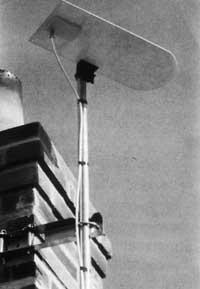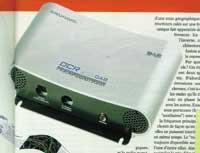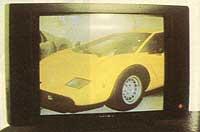Digital television with current antennas
2000/03/01 Azkune Mendia, Iñaki - Elhuyar Fundazioa Iturria: Elhuyar aldizkaria
Digital television has its advantages. On the one hand, the variety of programs is much greater than in analog, and on the other, they have better sound and image quality. So far only subscribers to cable or satellite television can access digital television. However, with the digital terrestrial network, that is, by receiving digital channels from the traditional Hertzian network of television, the advantages of cable or parabola television would be eliminated. For the capture of the channels of the land it would be necessary to give the existing "grills" on the roofs similar technical options to the others. The terrestrial network has been completed for many years, but nevertheless, the TDF organization has announced that in France some twenty digital chains will be broadcast in 2001.
Analog system
Let's first look at how the current analog network works. Each channel or television network has its own broadcast frequency. For the emission of image and sound, its signals are modulated by auxiliary frequencies of contrast, color and sound. In other words, the amplitude and frequency of the original wave are modulated according to the auxiliary waves. These waves are also directly image, color, and sound. There is therefore an analogy between the change of these frequencies and the “message” to be conveyed.
In this system a single program is broadcast on a frequency or channel and cannot be broadcast anymore. To change the station or program it is necessary to change the reception frequency on the TV receiver (also on the radio when we want to move from one station to another when we turn the button).
On the other hand, the auxiliary frequencies of the modulated signal cover the Hertzian section assigned to the television, that is, the frequency beam received by the signal covers a wider range than if it were a single wave and a vacuum. That is why we must respect a wide range of frequencies between both TV channels.
Digital system
Things are different in the digital system. The first thing to do is digitize the program to issue. Each image becomes a succession of symbols "0" and "1" that correspond to the brightness and color of each point on the screen. Next to it, another succession of the signals "0" and "1" replaces the sound. This digitization process generates millions of figures per image and if all had to be transmitted it would occupy a more Hertzian space than the analog system.
Instead, in the digital system the data is compressed. The long sequences of "0" and "1" are significantly shortened thanks to the compression software available for this purpose. The MPEG 2 standard is used for terrestrial digital television. The image is based on zoning and movement interpolation. The image is not transmitted by dots, but by uniform tone polygons. In addition, movements are extrapolated from one image to the next. Thus, with a few images animated sequences are formed.
The place earned allows to include between 4 and 7 digital channels in the range that occupies each terrestrial analog channel. The digitized data is emitted successively at the same frequency by multiplexing (see figure). On the other hand, in analog many times the signals exceed their frequency range, but in the digital system no. That is why next to the analog signal the other digital can be emitted without interacting between both systems.
User status
How is the transition from analog to digital? Our television receivers and video magnetoscopes are not prepared to receive digital broadcasts. So, will we have to change these devices? Will we have to place new TV receivers and magnetoscopes?
France has set two deadlines. From 2001 to 2011, approximately, there will be two systems on the terrestrial network. From there, however, there will be only a digital system. In this case, the television receivers must be digital, or the current analog receivers will be placed a digital encoding box.
To facilitate the transition from analog to digital, the French organization TDF will place digital emitters on the repeaters of the current network. Therefore, it will not be necessary to change the direction of the antennas of the homes or modify the existing installation. In addition, during the transition, the same antenna can receive the corresponding chains to the analog and digital network. Therefore, in a first phase you can change the TV receiver leaving the previous analog magnetoscope or vice versa. In blocks with many homes, some will want to move to digital, but others will not.
After the transition period, what to do for TV sets that do not work in the digital system? Should they be thrown away? They can walk with Setup Box or decoder, but this remedy will be of little time. What the government and manufacturers want is to sell digital devices at the price of analogues by 2011. Philips, Thomson, Siemens and many others.
Other digital television options
Digital television will have its advantages immediately. Without changing the installation the viewer will have many more strings and can choose the format of the screen (4/3 or 9/16). In addition, subtitles and sound can be broadcast in many languages. On the other hand, it should be noted that digital television is ideal for broadcasting movies based on orders (pay per view).
There will also be interactive apps like teleshopping or internet browsing. To do this, you will need a "return channel" to receive the commands of the user or viewer. In the first phase this task will be carried out by the telephone network. The GSM network for mobile phones will be used on portable devices.

Gai honi buruzko eduki gehiago
Elhuyarrek garatutako teknologia





